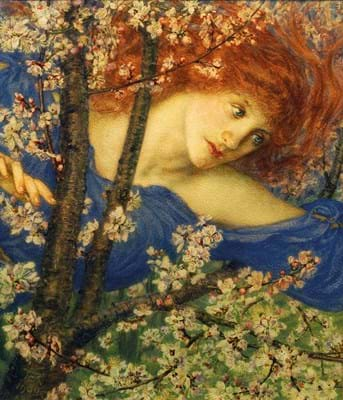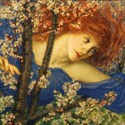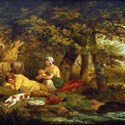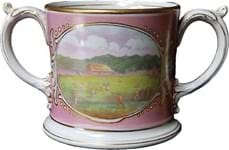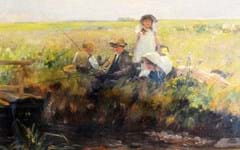A small watercolour by Edward Burne-Jones’ longest-serving studio assistant emerged as the star of a south London auction.
Depicting a Pre-Raphaelite beauty with signature flaming red hair, the signed 14½ x 13in (37 x 33cm) work was painted in 1900 by Thomas Matthews Rooke (1842-1942).
Consigned directly from the artist’s family to Roseberys’ (25/20/12% buyer’s premium) sale in West Norwood of Old Master 18th and 19th century pictures on March 20, it was knocked down to an anonymous buyer at £13,500 against an estimate of £800-1200.
Marcus Grey, head of the Roseberys picture department, described it as a “beautiful Pre-Raphaelite signed watercolour, fresh to the market from the estate of the artist’s family in a modern frame, but with the remains of the original backboard attached to the verso”.
Titled Phyllis Deserted – Become the Spirit of the Almond Tree, the watercolour is based on the classical fable of the heartbroken Phyllis, Queen of Thrace, who committed suicide after the desertion of her lover Demophoon and was changed by the gods into an almond tree as eternal compensation.
The story was popular among the Pre-Raphaelites. Burne-Jones painted the legend in his famous 1882 work The Tree of Forgiveness now in Lady Lever Art Gallery in Port Sunlight, on the Wirral.
Rooke’s most sought-after pictures on the secondary market are those that pervade Burne-Jones’ style, although his prices are rather more modest than Burne-Jones and the other major names connected with the Pre-Raphaelites.
Autumn Pipes, a figural work inspired by the Pre-Raphaelites and created with technique influenced by the Arts & Crafts movement, took $180,000 (with fees) at Sotheby’s New York in 2006. Another oil closer to the example at Roseberys, titled Susannah and telling the apocryphal story of Susannah and the Elders, sold at Bonhams in 2014 for £7500.
As well as his close ties with Burne-Jones and the Pre-Raphaelite movement, Rooke was associated with the Royal Academy.
He was prolific in producing drawings and detailed watercolours of buildings and architectural views, which he did under the patronage of John Ruskin.
These, rather than his figurative subjects, are more commonly seen on the auction block.
Rowlandson and the rostrum
Another eagerly contested lot was an original c.1784 drawing by Thomas Rowlandson (1756-1827) titled A Furniture Auction.
Bearing an old Spink label to the frame, the 7½ x 10in (19 x 26cm) pen and sepia ink and grey wash drew multiple bids before it was knocked down at £4000, around seven times the top guide.
Another version, possibly the same drawing, sold at Sotheby’s in 2004 for £17,000 – an illustration of how prices for 18th century drawings have dipped in recent years. Another Rowlandson auction subject showing James Christie on the rostrum of the then newly-emerging eponymous auction house sold at New York saleroom Swann for $11,250 (with fees) last September.
Elsewhere in the West Norwood sale, two late oils by contemporaries John Nost Sartorius (1759-c.1830) and George Morland (1763-1804) sold above attractively pitched estimates at £8000 and £7500 respectively. Both pictures were described by Grey as emanating the “tranquil and old world feeling of country pursuits by masters of the subjects”.
Sartorius, who concentrated on horses, horse-racing and hunting scenes, is considered the best-known and prolific of the Sartorius family of artists, highly fashionable among leading sportsmen and aristocrats of the day.
The 2ft 1in x 2ft 8in (63 x 83cm) oil on canvas of a sportsman with two dogs and a horse carried an 1805 date, placing it in the artist’s mature period when his style became more refined and less naive.
A note to the reverse of the picture by Morland stated that the artist’s style developed from 1790 “to suit his taste of painting English rural scenes… Thereafter, gypsies, shepherds and travellers resting and reposing in woodland and countryside scenes became a common theme of Morland.”
The bucolic scene at Roseberys depicting a weary traveller and his family resting by a stream had an old gallery label from 1947 and had last appeared at auction in 1990 at Christie’s, although it seems likely it was bought in as a record of its sale has not been found.
Going ape
Among the most decorative works in the sale was a portrait of a girl holding a pet monkey catalogued as ‘circle of’ Pierre Gobert (1662- 1744), a favourite French court portrait during the reign of Louis XIV, particularly among women.
The 2ft 2in x 21in (67 x 54cm) oil on canvas drew multiple bids before it was knocked down at £6000, four times the bottom guide.


